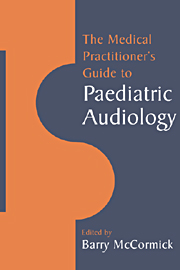Book contents
- Frontmatter
- Contents
- List of contributors
- Preface
- Acknowledgement
- 1 Introduction to hearing problems in childhood
- 2 Causes of deafness
- 3 Behavioural tests
- 4 Pure tone audiometry
- 5 Objective hearing tests
- 6 Middle-ear measurements
- 7 The management of otitis media with effusion
- 8 Management of unilateral hearing loss
- 9 Management of sensorineural hearing loss
- 10 Cochlear implants
- Index
2 - Causes of deafness
Published online by Cambridge University Press: 01 October 2009
- Frontmatter
- Contents
- List of contributors
- Preface
- Acknowledgement
- 1 Introduction to hearing problems in childhood
- 2 Causes of deafness
- 3 Behavioural tests
- 4 Pure tone audiometry
- 5 Objective hearing tests
- 6 Middle-ear measurements
- 7 The management of otitis media with effusion
- 8 Management of unilateral hearing loss
- 9 Management of sensorineural hearing loss
- 10 Cochlear implants
- Index
Summary
Causes of deafness
In considering a topic as wide ranging as deafness it is important to have a framework on which to hang the main elements to be discussed. There are many different ways of classifying deafness, two of which will be used for this chapter. With the framework established, salient points within each category will be discussed.
The most fundamental classification system is based on the site of the hearing loss and therefore on the nature of the loss. Deafness may result from pathology in the external or middle-ear causing a conductive hearing loss – a failure of transmission of the sound signal from the outside world to the inner ear. Sensorineural deafness arises from pathology either within the inner ear, a sensory or cochlear loss, or from pathology in the neural pathways connecting with the brain, a neural or retrocochlear deafness. With the development of cochlear implantation as a means of treating profound deafness it is no longer only of academic interest to differentiate between these two groups of causes of deafness; cochlear implantation is of benefit only if the central neural pathways remain intact and is therefore not appropriate in cases of retrocochlear deafness. Conductive deafness is considerably more common than sensorineural deafness, the latter having a prevalence of one or two per thousand (Davis and Wood, 1992).
In addition to the two main sub-groups, conductive and sensorineural deafness, a third extremely rare group may be identified, central deafness, in which the pathology lies within the auditory cortex.
- Type
- Chapter
- Information
- Publisher: Cambridge University PressPrint publication year: 1995

